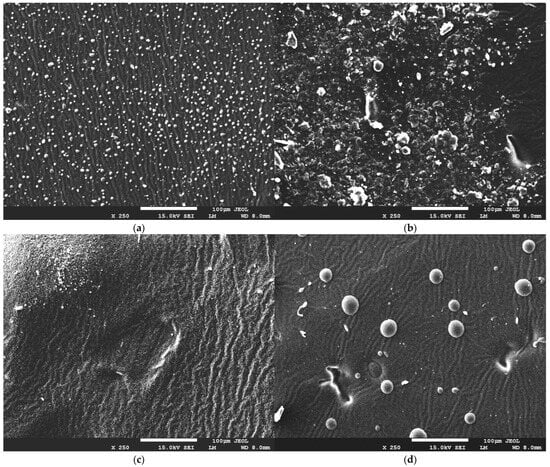The authors wish to make the following corrections to this paper []: In the original publication, there were mistakes in Figure 7 and the main text as published. The original figure is not of the right sample, which led to the wrong discussion in Section 2.3. We have re-imaged these materials and included the corrected images in this figure. The corrected Figure 7 and the main text appear below.

Figure 7.
SEM images of hydrogel materials containing different contents of crosslinking agent and royal jelly: (a) sample 30_30, (b) sample 30_40, (c) sample 60_30, and (d) sample 60_40.
Section 2.3 on page 9. The second paragraph is changed to the following: SEM micrographs show us that the addition of royal jelly to hydrogel materials manifests in the appearance of visible granules on the surface, with a spherical, regular shape. A higher amount of crosslinking agent causes an intense breakout of granules and irregularities on the surface of the hydrogel material. This is related to the polymerization process, in which appropriate proportions of components during the polymerization reaction lead to a material with a more uniform structure or a material with visible morphological changes. Nevertheless, the structure of the obtained materials is undulating and porous, indicating that there is no effect of bee milk on the hydrogel structure itself.
Section 3.5 on page 17. Line 1, the sentence is changed to the following: The highly dried hydrogel materials were investigated using the JEOL JSM-7500F scanning electron microscope (Jeol Ltd., Tokyo, Japan). Line 4–6, the sentence is changed to the following: Then, the samples with dimensions 1.0 cm × 1.0 cm × 0.1 cm were cut from the hydrogels and sputtered with chromium to provide a layer on the hydrogels’ surfaces.
The authors state that the scientific conclusions are unaffected. This correction was approved by the Academic Editor. The original publication has also been updated.
Reference
- Kudłacik-Kramarczyk, S.; Krzan, M.; Jamroży, M.; Przybyłowicz, A.; Drabczyk, A. Exploring the Potential of Royal-Jelly-Incorporated Hydrogel Dressings as Innovative Wound Care Materials. Int. J. Mol. Sci. 2023, 24, 8738. [Google Scholar] [CrossRef] [PubMed]
Disclaimer/Publisher’s Note: The statements, opinions and data contained in all publications are solely those of the individual author(s) and contributor(s) and not of MDPI and/or the editor(s). MDPI and/or the editor(s) disclaim responsibility for any injury to people or property resulting from any ideas, methods, instructions or products referred to in the content. |
© 2024 by the authors. Licensee MDPI, Basel, Switzerland. This article is an open access article distributed under the terms and conditions of the Creative Commons Attribution (CC BY) license (https://creativecommons.org/licenses/by/4.0/).